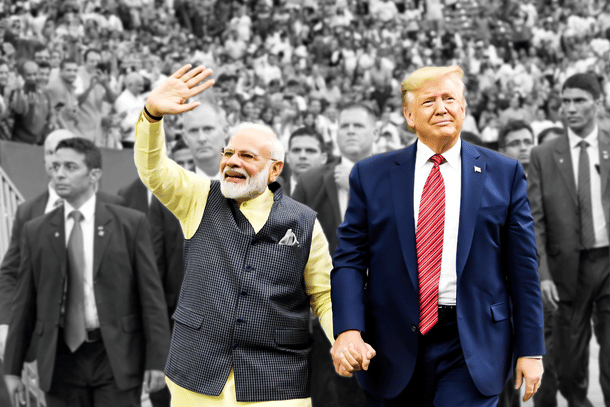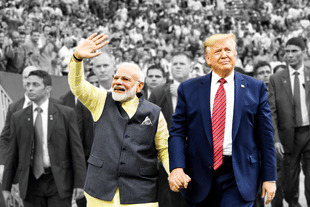World
Trump Visit: US Wants Access To Indian Dairy And Chicken Market But Could Settle For A Watered Down Deal
M R Subramani
Feb 17, 2020, 06:15 PM | Updated 06:21 PM IST
Save & read from anywhere!
Bookmark stories for easy access on any device or the Swarajya app.


Last week, a Reuters report said that India has offered to partially open its poultry and dairy trade to the US as part of its bid for a limited trade deal during US President Donald Trump’s visit to India on 24 and 25 February.
The report, attributed to “people familiar with protracted talks” was silent if the “people familiar” were from the US or Indian side. It, however, said that US Trade Representative (USTR) spokesman and Indian Commerce Ministry did not respond to requests for comments.
The very next day, Indian officials denied that New Delhi had come up with any such offer.
The initial report also said that the US Trade Representative Robert Lighthizer had called off his trip to India, indicating that a trade deal might not take place.
Currently, India-US trade is in a state of flux with Washington trying to derive the maximum from New Delhi and the latter resisting it, particularly to protect the interests of its farmers and its industries.
Probably, the US move last week to drop India from the list of developing countries has complicated things. This will end preferential treatment to Indian products and lead to imposition of countervailing duties.
Though the move is not linked to Trump’s visit, it has now emerged as a trade issue in the talks. The US President’s visit might now see a limited deal and, probably, commitments from India to look into US demands for market access.
Besides access to Indian poultry and dairy markets, the US also wants India to lift the price cap on medical devices, especially heart stents, by India, lower customs duties on motorcycles, walnuts, toys, electronics and other products.
The budget proposals, tabled in Parliament on 1 February, have raised the duties on all these products. The hike in the duties also caught Washington authorities working on the trade deal by surprise.
The Reuters report said India had offered to bring down the import duties on chicken legs to 25 per cent but the US insisted on 10 per cent. Indian officials, however, said that its chicken import regime was compliant of the World Trade Organisation (WTO) rules.
The US had gone to the WTO dispute panel to get market access for its chicken legs that India did not provide for long. However, India has been looking to accede to US requests by cutting the duty from 100 per cent to 30 per cent.
However, the poultry industry fears that it will be hurt badly by such a decision as Indian consumers prefer chicken legs. The country’s maize (corn) and soybean sectors could also be affected since the domestic poultry sector is the primary consumer of these feed products.
The poultry sector claims that it could lose 25-40 per cent of its profit. Countries such as the US and Brazil, which has also begun to export chicken legs to India, could be shipping the product at a cheaper price as they could protect their margins through sale of the chicken breasts.
On the other hand, the US is desperate to export chicken legs because its consumers prefer chicken breasts and hence other consumers have to be found for the legs.
Commerce Ministry officials say the import may not affect the sector much as these are frozen products that are consumed only by a small section in the domestic market.
However, allowing dairy products from the US could prove a tricky issue since there is a religious element to it. In the US, the cattle are fed with feeds that contain internal organs, blood meal and tissues of ruminant.
India has told the US that it could allow dairy imports at five cent duty, though the quantity permitted will be capped, provided Washington certifies that the dairy products are not derived from such animals.
Besides the issue of religious sentiments, such animals can develop mad cow disease which sometimes can affect humans in the form of Creutzfeldt-Jakob disease which is fatal.
Moreover, 80 million households in rural parts of the country are involved in the dairy industry and allowing dairy imports could turn into a controversy.
Last year, the Indian dairy industry was among those to vehemently protest the Regional Comprehensive Economic Partnership that allowed import of dairy products from member-countries, especially New Zealand. New Delhi has, however, not gone ahead with the deal as it finds the deal against its interests.
The US is also seeking access to its agricultural products such as blueberries, walnuts and cherries. However, India’s problem is that the grower lobbies are opposed to this as also the Swadeshi Jagaran Manch, a sister organisation of the Rashtriya Swayamsevak Sangh.
Commerce Ministry officials say negotiations are underway over the products on which customs duties were raised last year. These are almonds, walnuts, apples and wines, whose duties were raised to 100 per cent.
India’s customs duty hike was seen as a retaliation to the US decision of imposing 25 per cent additional duty on steel and 10 per cent additional duty on aluminium. India has also been affected by the US withdrawing the generalised system of preference (GSP) for its exports.
The US wants India to buy more from it as its trade deficit with India was $17 billion during the last fiscal. US trade deficit has been declining with India buying oil and gas and defence products from it.
On the price cap for medical devices, India has made it clear that it will not lift the cap but would rationalise the trade margins to allay the fears of importers. The Centre is looking into two such recommendations on this.
The NITI Aayog has recommended that the trade margins on medical devices be fixed at 65 per cent, while the Department of Pharmaceuticals has suggested the margin at 50 per cent.
The Narendra Modi government introduced the price cap on medical devices to improve the public health system and boost affordability of the devices to the public.
The government has been of the view that high margins imposed by the producing companies had led to devices such as heart stents and catheters becoming unaffordable to a large section of the public.
Indian authorities are convinced that New Delhi’s priorities are protecting the interests of its agricultural sector and consumers. On the other hand, Washington is trying to help its industries gain access to important markets such as India.
In a situation where each country thinks that their viewpoint is right, it is most likely that some meeting point could be found. In the case of India, it is offering US opportunities to export defence products, oil and gas, while being open to certain issues.
For the US, deals that show US entrepreneurs gaining are important. While a trade deal is unlikely in the short-term, it is likely that India and the US will sign a couple of deals in the defence, oil and gas sectors.
M.R. Subramani is Executive Editor, Swarajya. He tweets @mrsubramani





